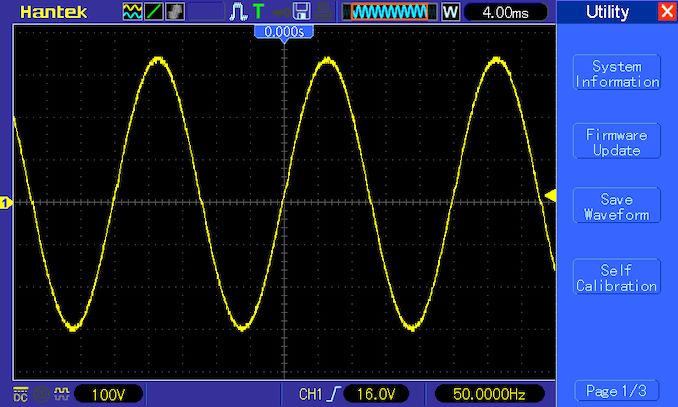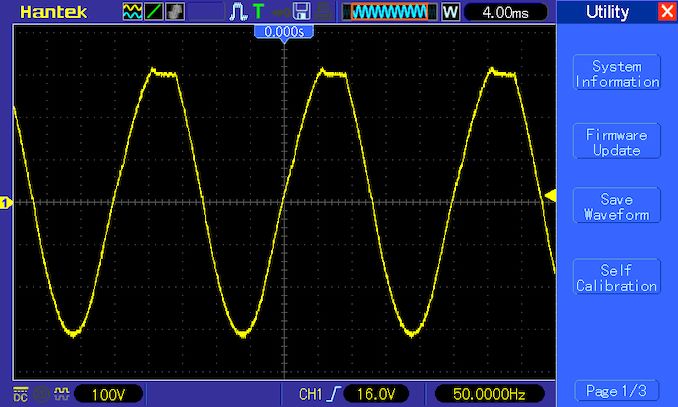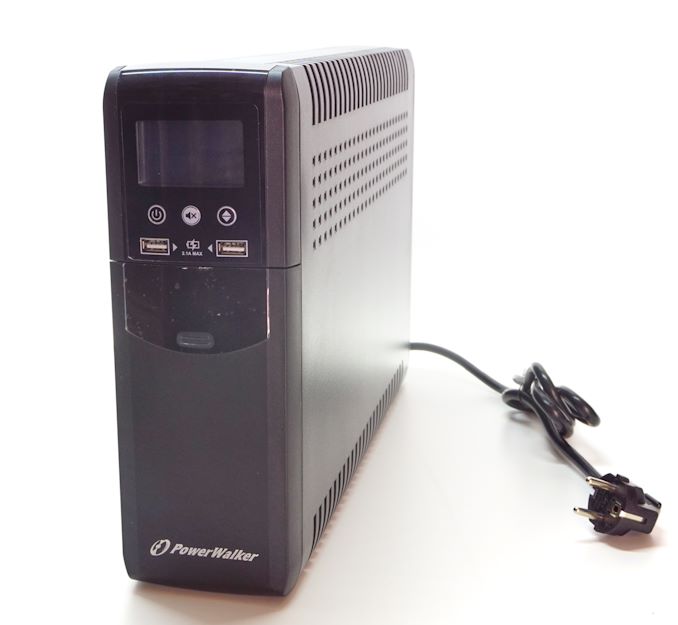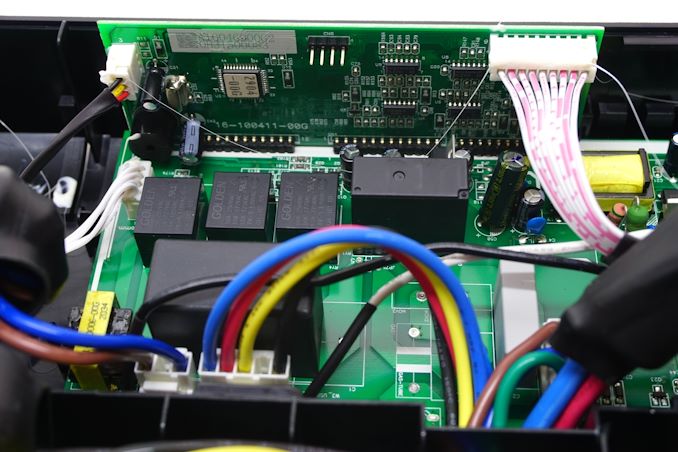The PowerWalker VI 1500 CSW UPS Review: Trying For True Sinewave on a Budget
by E. Fylladitakis on April 13, 2022 8:00 AM EST- Posted in
- Cases/Cooling/PSUs
- UPS
- PowerWalker
- BlueWalker
- 1500VA
Testing
Putting the PowerWalker VI 1500 CSW to the test, the basic electrical figures of the UPS are acceptable, with the unit delivering the performance it promises. When it operates on battery power, the voltage output is exactly 224 V RMS regardless of the load. There are minor frequency variations but these are exceptionally small. The transfer time is relatively high, yet not out of the manufacturer’s specifications. Though it also seems to significantly depend on the load, which should not be happening to this extent.
| UPS Load Performance | |||||
| 10% | 25% | 50% | 75% | 100% | |
| Voltage Output (Vrms) | 224 | 224 | 224 | 224 | 224 |
| Frequency (Hz) | 50.05 | 50 | 50 | 49.95 | 50 |
| Transfer Time (ms) | 6.1 | 7.6 | 7.8 | 7.6 | 8.9 |
The fan of the unit outputs 41.6 dB(A) once it is running. By UPS standards this is not a very high figure, but it's certainly not a very comfortable amount of noise, either. The downside here is that the PowerWalker VI 1500 CSW requires nearly 10 hours to fully charge its batteries once they are completely empty, which could be a problem with the unit installed in a living room or, worse, bedroom.
In our load testing, we've found that the battery runtime of the PowerWalker VI 1500 CSW is even better than advertised. These figures are achieved with its batteries fully charged and while they are new.
The PowerWalker VI 1500 CSW boasts true sinewave output, and our testing confirms this. Under load, our instruments showing a nearly-perfect sine wave with the unit running on battery power – but only while the load is low. Once the load reaches 50% (450 Watts) the deformation of the sine wave becomes apparent. It also becomes deformed abnormally, with only the positive peaks getting chopped, meaning that it is only one half of the circuitry failing to perform. At nearly 90% load (800 Watts) the waveform is nearly square, with both peaks heavily chopped, suggesting a massive number of harmonics. This will definitely not be healthy for any device that requires a pure sinewave input, such as APFC circuitry and AC motors.
Conclusion
The PowerWalker VI 1500 CSW is a UPS designed to combine a high output and true sinewave capability at a retail price affordable for most home consumers. At around €180, it currently retails for half of the price reputable manufacturers ask for their equally powerful true sinewave products, making it a very enticing deal.
The build quality of the PowerWalker VI 1500 CSW is better than one would expect from a product retailing at this price. Its parts are coming from reputable manufacturers and the unit is very well assembled. The design is dated but that is not inherently wrong – it just means the unit isn't geared to deliver the kind of top-of-the-line performance that more recent designs can provide.
When it comes to performance, the PowerWalker VI 1500 CSW performs, for the most part, according to its specifications. The trade-offs and issues become apparent when a closer look is taken, revealing that its electrical performance leaves a lot to be desired. The unit fails to maintain a true sinewave output when the load exceeds about 25% of its rated capacity, which could lead to serious issues if an application requires a true sinewave input. To be sure, for most home applications like modern PCs and TVs, this will not be a significant issue, as they take measures against harmonics and the expected load is usually but a fraction of the unit’s maximum output. However, if the unit needs to run at its maximum output or to drive loads that are very sensitive to harmonics, such as electric motors or older PCs, it could have damaging results to the equipment.
Ultimately, for users who are currently on the market for a UPS that is expected to mostly run at low loads, such as for safeguarding a single PC and its peripherals, the PowerWalker VI 1500 CSW is a fine choice. The UPS offers a clean enough electrical feed to meet the needs of a PC (or similarly switching power supply device), and it has the headroom to handle the stress if the power outage happens when the system is very heavily loads (e.g. while gaming). However, it is very clearly a device that was designed against engineering trade-offs to bring down costs for its target market. So, due to its inability to maintain a clean true sinewave output, we cannot recommend it for sensitive applications, and prospective users will want to be especially careful analyzing the sensitivity of their equipment to harmonics before purchasing it.
















107 Comments
View All Comments
Ryan Smith - Wednesday, April 20, 2022 - link
It depends on reader interest, and how eager manufacturers are to sample. There's no reason we can't do 4-5 a year if the supply and demand are there.Oxford Guy - Thursday, April 14, 2022 - link
I read quickly but saw nothing about the fact that lead-acid batteries are permanently degraded by being discharged. The article mentioned a 12-hour recharge time for when the batteries have been completely depleted but didn’t mention the far more pertinent matter of lead sulphate. That is the chemical that forms when lead acid batteries are discharged, even partially. It is a byproduct of the degradation inherent in the tech.Lead-acid batteries have no place in a device like this. People who wish to debate that should truly look at the big picture. This is not a device like a car which has a workload defined by the battery usually being mostly fully-charged (the one workload that is suitable for lead-acid tech). The article said the batteries in this unit can be depleted in a matter of minutes. This device is designed around much heavier depletion than a car, making it fundamentally unsuited to the battery tech.
Why do manufacturers choose to use lead-acid batteries for devices with the wrong workload? They’re counting on buyers looking at things like sine wave output and wattage — the same thing this review does.
Perhaps the business model here is to sell replacement batteries to make up for the reduced pricing of its partial sine wave ability.
The irony of consumer-grade UPS devices has been mainly about how prone they are to dying. A computer surviving multiple lightning storms with a simple surge blocker is more likely than these UPS devices lasting long enough.
A useful review will not only warn about the unsuitability of lead-acid batteries, it will be in two parts — the second being a long-term lifespan report. See if you can get a few years out of these products. See how much uptime lead-acid batteries manage after multiple discharges.
I can see using lead-acid batteries in a device that has an optional ‘emergency mode’ where the user can decide to engage them when the lithium batteries are nearing depletion. This could be a cost-saving way to give the unit longer uptime at a lower price point — suitable only for workloads that are unlikely, but not completely, to need the extra runtime.
Oxford Guy - Thursday, April 14, 2022 - link
It’s also bait and switch fraud to claim sine wave output for a device that does not produce sine waves over most of its output range.That should not be hand-waved with excuses about what most people might use the device for. The product is being sold on a lie.
back2future - Friday, April 15, 2022 - link
what needs regulation for advertisement and technical description for standardized consumer support and information (and consumers understanding their usage profile, planed/scheduled repairs/upgrades, replacement parts available and costs including wear/maintenance/refirmation, before purchase) (?)mode_13h - Thursday, April 14, 2022 - link
> Lead-acid batteries have no place in a device like this.The typical usage model is that the user saves their work, shuts down their PC, and then switches off the UPS. You're not necessarily supposed to run until the battery is 100% depleted.
> A computer surviving multiple lightning storms with a simple surge blocker
Surge suppression won't save you from lost work and possible file or filesystem corruption due to abrupt reboots.
> the second being a long-term lifespan report.
Here's my lifespan report. All of my co-workers have APC UPS units at their desk. Sometimes, we lose power when people aren't around to switch them off, and most haven't gone to the trouble of configuring auto-shutdown. Yet, we still typically get about 5 years out of these batteries (possibly more). At home, I've gotten over 7 years out of mine, which I've run down probably at least 3 times.
Yes, Lithium Ion would be great. However, as noted in other comments, there's a cost differential. And Lithium Ion have other tradeoffs.
You make some fair points, especially with your reminder about minimizing depletion of lead acid batteries. I definitely want to acknowledge that.
DanNeely - Friday, April 15, 2022 - link
I generally get 4 years/battery pack at home; OTOH my high power desktops (running distributed computing 24/7) mean I need a larger than normal chunk of the nameplate capacity to avoid an immediate shutdown on power loss.And with maybe 2-6 interruptions longer than a few seconds/year decay due to discharge cycles is basically irrelevant. (I find the person upthread ranting about the use of lithium batteries only good for several hundred rather than several thousand cycles upthread hilariously divorced from how typical UPSes are used.)
Oxford Guy - Friday, April 15, 2022 - link
Mr. Neely:Lead-acid batteries die partially whenever they are depleted, even partially. That is a the opposite of irrelevance unless the device is never used.
Being happy with a four-year lifespan is also quite debatable.
Oxford Guy - Friday, April 15, 2022 - link
Defining that lifespan is also fraught since it varies wildly by the circumstances and how each person defines the lifespan. One may claim the product is still working when the battery can only manage 15% of its original charge. Another will wait until the product simply doesn’t power up or whatever.mode_13h - Friday, April 15, 2022 - link
I define "lifespan" as "when the UPS tells me to replace the battery". I have no idea what that actually means, in terms of raw capacity, because my experience is that a UPS in that state won't even *try* to give you any runtime.I would advise people not to buy UPS batteries in advance, because they have some degree of self-discharge. And, as we've discussed, you don't want to them to have any significant amount of discharge.
For the same reason, I advise people to keep every UPS plugged-in (at least some of the time), even if they're not using it.
Oxford Guy - Saturday, April 16, 2022 - link
The numerous units we (myself and colleagues) have purchased have failed. It hasn’t merely been the batteries. That includes models claiming sine wave output. I am thoroughly unimpressed with what I have seen so far in terms of ‘affordable’ UPSs.